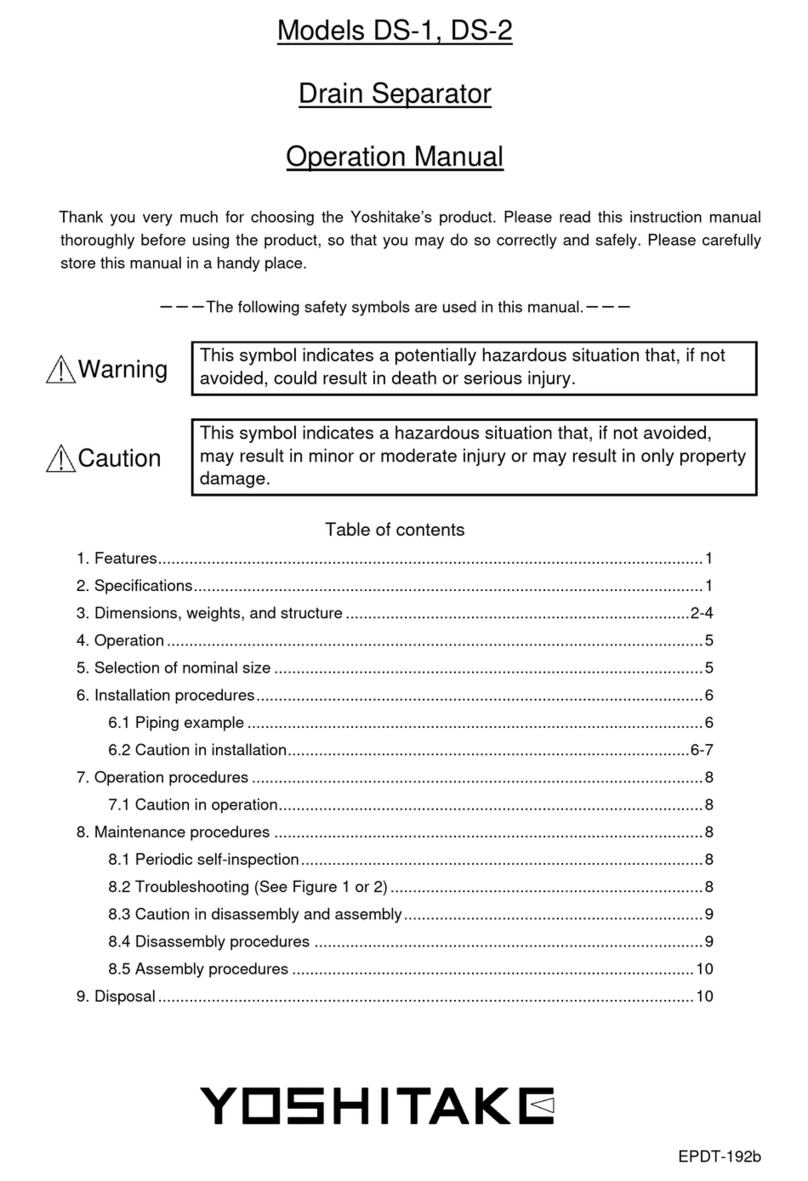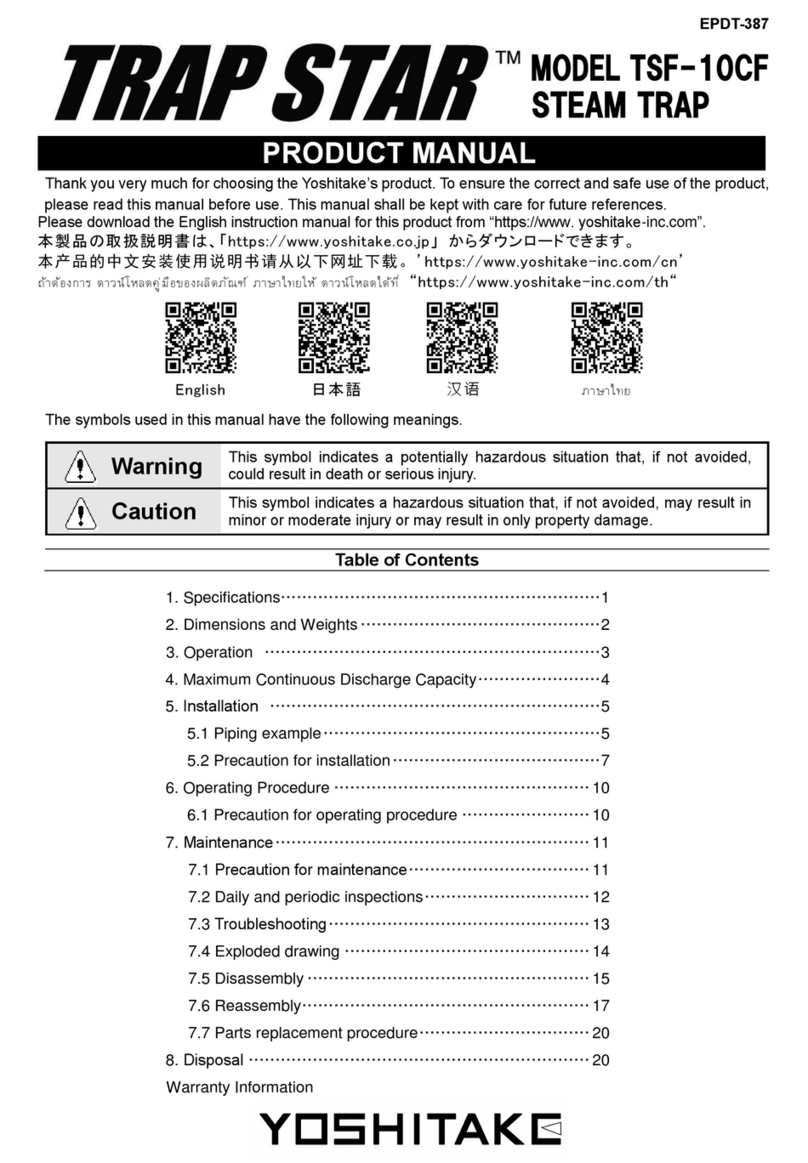Yoshitake TRAP STAR TSF-11AT User manual

EPDT-342a
PRODUCT MANUAL
.
Thank you very much for choosing the Yoshitake’s product. To ensure the correct and safe use of the product,
please read this manual before use. This manual shall be kept with care for future references.
The symbols used in this manual have the following meanings.
Warning
This symbol indicates a potentially hazardous situation that, if not avoided,
could result in death or serious injury.
Caution
This symbol indicates a hazardous situation that, if not avoided, may result in
minor or moderate injury or may result in only property damage.
Table of Contents
1. Usage of the Product·················································· 1
2. Specifications···························································· 1
3. Dimensions and Weights············································· 2
4. Operation ······························································· 2
5. Maximum Continuous Discharge Capacity ······················ 3
6. Installation
6.1 Piping example···················································· 4
6.2 Precaution for installation······································· 5
7. Operating Procedure
7.1 Precaution for operating procedure ·························· 7
8. aintenance
8.1 Precaution for maintenance ··································· 8
8.2 Daily and periodic inspections ································ 8
8.3 Troubleshooting··················································· 9
8.4 Exploded drawing ···············································10
8.5 Disassembly ······················································11
8.6 Reassembly·······················································13
8.7 Parts replacement procedure ································ 16
Warranty Information
AIR TRAP
MODEL TSF-11AT

1
.
Usage
of the product
The TSF-11AT efficiently discharges condensate without retention, preventing noise and corrosion of the
equipment and piping.
2
. Specifications
odel TSF-11AT
Nominal size 32A-50A
Application Air,Other non-dangerous fluid
Working pressure
( aximum working
differential pressure)
TSF-11AT-5 : 0.01-0.5 MPa (0.5 MPa)
TSF-11AT-10: 0.01-1.0 MPa (1.0 MPa)
TSF-11AT-21: 0.01-2.1 MPa (2.1 MPa)
ax. temperature 220°C
aterial
Body Ductile cast iron
Float Stainless steel
Valve,
valve seat
Stainless steel
Connection JIS Rc screwed
NPT screwed
Flow direction
Horizontal installation*
* The flow direction when shipping is adjusted from left to right. When using from right to left, see No.5, “6.2
Precaution for installation” on Page 6.
* For installation posture, see No.4, “6.2 Precaution for installation“ on Page 6.
Caution
1. Depending on application, specification of the product shall be selected. Refer to
Technical material, e.g. Product manual, Technical guidebook, and drawing, and
select suitable specification. Regarding technical material like drawing, contact our
sales office.
2. Please confirm that the indications on the product correspond with the
specifications of the ordered product model before use.
* If they are different, do not use the product and contact us.

2
3
. Dimensions and Weights
(mm)
4
. Operation
(1) Right after the installation, the product contains gas and the float (P) ⑥ is lowered by its own weight,
so the valve ⑧ is closed.
(2) When the condensate comes into the product, the float lifts up by buoyancy, floats up and the valve ⑧
opens to discharge the condensate.
(3) When condensate is discharged, the condensate level falls and the buoyancy to the float decreases,
and the valve ⑧ closes.
(4) Condensate can be discharged by repeating the operation of (2) and (3) thereafter.
⑧
Valve
⑦
Valve seat
⑥
Float(P)
⑤
Float holder
②
Cover
①
Body
№Parts name
model Nominal
size d LA A1
A2
H Plug Weight
(kg)
TSF-11AT
32A Rc or NPT1 1/4
190 244
147
75
210
Rc or NPT3/8
10.0
40A Rc or NPT1 1/2
205 244
147
75
210
Rc or NPT3/8
10.2
50A Rc or NPT 2 220 244
147
75
210
Rc or NPT3/8
10.5

3
5
. Maximum Continuous Discharge Capacity
1. Discharging capability of the air trap differs by working differential pressure, that is, difference between
inlet pressure and outlet pressure (back pressure). In selecting discharge capacity, consider outlet
pressure. If inlet pressure is 0.5 MPa and outlet pressure is 0.2 MPa, discharge capacity is of working
differential pressure of 0.3 MPa.
2. The discharge capacity shown in the charts below is the maximum value. In designing a system, select
an air trap with a sufficient safety factor (two times the regular level). That is, for example, if a discharge
capacity of 500 kg/h is required, select a steam trap capable of discharging more than 1,000 kg/h
(maximum discharge).
TSF- AT-5
TSF- AT- 0
TSF- AT-2
Maximum Continuous Discharge Capacity Chart
TSF- AT
Discharge Capacity (kg/h)
Working differential pressure (MPa)

4
6
. Installation
6. Piping example
Stop
Valve
Pressure
Gauge
Stop
Valve
Air Trap
Strainer
Stop
Valve
Stop
Valve
Vessel
Stop
Valve
Air Trap
Strainer
Pressure
Gauge
Stop
Valve
Stop
Valve
Stop
Valve
Stop
Valve
Stop
Valve
Stop
Valve
Drain Separator
Equalizing Line
Equalizing Line

5
Stop
Valve
Stop
Valve
By-pass Valve
Stop
Valve
Trap Trap
Stop
Valve
By-pass Valve
Description
Correct
Incorrect
If the product is installed close
to a regulating valve, make
sure to install the product at
the inlet side of the regulating
valve.
To discharge condensate from
the main pipe, be sure to
install the product so that
condensate can be discharged
from the bottom of the main
pipe by drip leg.
End portion of discharge pipe
shall be off the water surface in
the pit.
Provide a by-pass line around
the product, and install stop
valves at the outlet side of the
product.
6.2 Precaution for installation
Caution
1. Before connecting the product to piping, remove foreign substances and scale from the piping.
* Failure to follow this notice may prevent the product from functioning properly.
* To plumb the product, be careful to keep seal materials from entering into the product.
2. To install the product,
check the direction of the product so that the fluid flowing and the arrow marked
on the product are in the same direction.
* Setting the product in wrong directions prevents it from functioning properly.
3. Do not apply excessive load, torque or vibration to the valve.
* Doing so may result in malfunction or drastically shortened service life.
Regulating
Valve
Equalizing Line
Regulating
Valve
ain Pipe
Equalizing
Line
Drip Leg
Stop
Valve
Trap
ain Pipe

6
4. Check installation posture.
* Wrong posture hampers proper operation.
* Allowable tilt from horizontal line is within ±10°.
5. Adjust direction of the name plate in no pressure condition after installation.
* Do not turn the cock unless the pressure inside of the product and piping is completely discharged.
Forcing the cock to turn may result in damage to the cock.
* Wrong direction hampers proper operation.
* Fix the cock with spanner and loosen the
nut. Turn the cock and adjust direction of the
name plate to position "TOP" and "BOTTOM"
signs on upside and downside respectively.
* Fix the cock with spanner and fasten the nut
after adjustment.
* Allowable tilt from vertical line is within ±10°.
6. Make sure to support the piping immovably.
* If an excessive piping stress is applied, the product may not open or close.
7. Do not disassemble the product unless it is necessary.
* Disassembly may prevent the product from functioning properly.
8. Secure enough space for maintenance (such as cleaning of strainer), inspections and repair as
shown below.
* Failure to follow this notice prevents maintenance, inspection and repair.
Name plate
Cock
UP
DOWN
Nut
UP
DOWN
UP
DOWN
300 mm or more
TOP
BOTTOM
WRONG

7
9. Slope
the piping and place the product at as a low position as possible in order to make condensate
flow into the product by its own weight.
10. To install the product in a main pipe, provide a drip leg at the inlet side of the product.
11. Install a strainer (mesh size of 80 or more is recommended) at the inlet side of the product.
12. Install the product so that it is not subjected to the shock of water hammer. Do not install a quick operating
valve before and/or after the product.
* Failure to follow this notice may result in malfunction due to damage to the float, or may result in scalds
or injury due to blow off when the product is subjected to an excessive shock and damaged.
13. Install a bypass line.
* The system has to stop operation while inspection and maintenance of the product if the bypass line is
not installed.
14. Be sure to install an equalizing line to prevent condensate accumulation.
*Install an equalizing line above the condensate level in the product.
7. Precaution for operating procedure
Warning
1. Before leading fluid, make sure that the product is securely connected to piping and that there is no
loose.
* Failure to follow this notice may result in scalds or injury due to blow-off.
2. Do not touch the product with bare hands while the product operates when using high temperature fluid.
* Failure to follow this notice may result in scalds.
3. Do not stand in front of the outlet opening of the product while the product operates.
* Failure to follow this notice may result in scalds or injury due to blow-off.
Caution
1. Slowly open each stop valve to prevent water hammer.
* Opening stop valves quickly may result in damage to other equipments due to hunting or water
hammer.
2. Do not turn the cock while the product operates.
* Do not turn the cock unless the pressure inside of the product and piping is completely discharged.
Forcing the cock to turn may result in damage to the cock.
* Wrong direction of the cock hampers proper operation.
8
. Maintenance
8. Precaution for maintenance
Warning
1. When using high temperature fluid, do not touch the product with bare hands.
* Failure to follow this notice may result in burns.
2. Be sure to completely release the internal pressure of the product, piping, and equipment when
disassembling and maintenance. In the case of high temperature fluid, please cool the product body
until it touches with bare hands.
* Failure to follow this notice may result in scalds or injury due to residual pressure.
7
. Operating Procedure

8
Caution
1. Conduct daily inspection in order to maintain the optimal performance of the product.
* Failure to follow this notice may prevent the product from functioning properly.
* See “8.3 Troubleshooting” on Page 9 if trouble is observed.
2. After leaving the product not operated for a long period, perform inspection before start-up of operation.
* Failure to follow this notice may cause malfunction due to rust inside of the product and piping.
3. Put a container under the product at disassembly since condensate may flow out.
* Failure to follow this notice may result in making the surroundings dirty.
4. Be careful not to drop the parts at the time of disassembly. The disassembled parts should be placed
on soft cloth in order to avoid scratches and damage.
* Damage on the parts may cause malfunction and affect the optimal performance.
5. To assemble, connect all the parts securely and tighten the bolts uniformly in diagonal order.
* Failure to follow this notice may cause malfunction or outside leakage.
6. When repairing, do not use the parts other than the dedicated parts manufactured by Yoshitake. Do not
modify the product.
* Failure to follow this notice may cause damage to the product, or may result in scalds or injury due to
blow-off or malfunction.
7. In case of problems due to foreign substances or scale, the product needs repair or part replacement.
Please contact us for details.
(Please note that any repair due to foreign substances or scale in the product is subject to a charge
even during the warranty period.)
8.2 Daily and periodic inspections
Conduct daily and periodic inspections in order to maintain the optimal performance of the product.
See ”8.3 Troubleshooting” on Page 9 for the remedies if trouble is observed.
Daily inspection (once a day)
Conduct daily inspection during operation of the product.
Items
Standards for Inspection
Discharge condition
of condensate Condensate is discharged smoothly.
Outside leakage No outside leakage of condensate or fluid.
Periodic inspection (once a year)
Conduct disassembly inspection periodically.
Items
Standards for Inspection
Seat surfaces
of the
valve and valve seat
No scratch, abrasion, or foreign substances on seat surfaces.
Shape of float (P) No deformation or damage on the float (P)
Dirt on the screen No clogging on the screen

9
8.3 Troubleshooting
Trouble Cause Remedy
Condensate is not
discharged.
1.
Blockage of foreign substances in
a discharge hole of the valve seat.
1.
Disassemble and clean it.
2.
The screen is clogging.
2.
Disassemble and clean it.
3.
The float
(P)
is damaged.
3.
Replace
it
with a new one.
4.
Breakage as a result of abnormal
pressure rising due to freezing or
water hammer, etc.
4.
Replace the product with new one and
use it within the working pressure range.
5.
Condensate
accumulation has
occurred in the equalizing line.
5.
Please review the layout of the equalizing
line to prevent the occurrence of
condensate accumulation.
6.
“
TOP
”
and
“
BOTTOM
”
signs on
the name plate are in wrong
positions.
6. Adjust direction of the name plate to
position "TOP" and "BOTTOM" signs on
upside and downside respectively.
* See Caution No. 4, “6.2 Precaution for
installation
”
on Page
6
.
Continuous blowout.
1.
Foreign substances stuck on valve
or valve seat.
1.
Disassemble and clean them.
2.
Abrasion or
scratch
es
on the valve
or valve seat.
2.
Replace the parts
with new ones
.
3.
Insufficient capa
city
of the
product.
3.
Replace the product with another model
of sufficient capacity.
4.
“
TOP
”
and
“
BOTTOM
”
signs on
the name plate are in wrong
positions.
4.
A
djust
direction of the
name plate to
position "TOP" and "BOTTOM" signs on
upside and downside respectively.
* See Caution No. 4, “6.2 Precaution for
installation
”
on Page
6
.
Outside
leakage.
1.
Leakage due to loosening of the
bolt.
1.
Replace the cover gasket with
new one,
and retighten the bolt.
2.
Leakage due to deterioration of
cock gasket (P2) and O-ring.
2.
Replace the parts with new ones.
3.
Leakage as a result of abnormal
pressure rising due to freezing or
water hammer, etc.
3.
Replace the product with new one and
use it within the working pressure range.

10
9.4 Exploded drawing
The parts shown in the rectangle boxes are available as consumable supply.
※Remove the plug on the “TOP” side and install an equalizing line.

11
8.5 Disassembly
Tools to be used
Name of tool Size (Nominal size)
Spanner 22 mm
Ring wrench 19 mm
[Procedure 1]
[Procedure 1] Loosen the bolts fixing the cover with ring wrench (width across flat: 19
mm), and remove the cover and gasket from the body. Pull out the
screen from the body.
[Procedure 2] Pull out the spindle from the float holder and remove the float (P)
assembly.
Spindle

12
[Procedure 4]
[Procedure 3] Remove the split pin from the cock. With fixing the cock (width across
flat: 9 mm), remove the nut by using spanner (width across flat: 22 mm),
and then remove the collar and the name plate.
By pulling out the cock from the cover, the cock assembly can be
replaced.

13
8.6 Reassembly
Tools to be used
Name of tool Size (Nominal size)
Torque Wrench
* Tightenable with torque of 45 N・m
Width across flat: 19 mm
Torque Wrench
* Tightenable with torque of 35 N・m, Open-head type
Width across flat: 22 mm
Spanner 9 mm
Ring Wrench 22 mm
OK
WRONG
[Procedure 1]
[Procedure 2]
Check that the cock gasket (P1), plate, cock gasket (P2) and O-ring
(P11) are attached to the cock. Apply lubricant agent to the cock gasket
(P1) at its contacting surface with the cock (Recommendation:
SOLVEST No.110 paste, STT Inc.). Apply fluoro grease to the O-ring
(Recommendation: SOLVEST No.245, STT Inc.).
Attach the cock (after taking Procedure 1) to the cover. Check that the
cock gasket (P1) is attached to the cock properly. If not, it may cause
leakage to the outlet side.
Cock gasket (P1)
O-Ring
The cock gasket (P1) is out
of the groove of the cock.
The cock gasket (P1) fits
in the groove of the cock.

14
OK
WRONG
[Procedure 4]
[Procedure 3] Attach the name plate, collar, and nut to the cock.
* When installing, match the holes on the name plate and collar with
shape of the cock.
Connect the float holder and float (P) assembly with the spindle. Check
that the float (P) assembly moves smoothly, and that the seat surface
of the valve is in contact with that of the valve seat.
[Procedure 5] Attach the screen to the body. The screen can be inserted from either
end.
The valve is above the spindle.
The valve is below the spindle.
Put the D-shaped
portion in the same
direction.

15
[Procedure 7]
[Procedure 6] Install the cover gasket to the cover. ake the oval-shaped holes on
the cover and on the cover gasket in the same position. ake sure to
use a new cover gasket. Apply lubricant agent to the cover gasket
(Recommendation: SOLVEST No.110 paste, STT Inc.).
Install the cover to the body, making the oval-shaped holes on the cover
and on the body in the same position. Tighten the bolt with torque
wrench (width across flat: 19 mm) with torque of 45 N・m.
* Do not use impact wrench to tighten the bolt. Using it may cause
unevenly tightened bolt or damaged gasket, resulting in outside
leakage.
Cover
Body
Oval-shaped
hole
ake the oval-
shaped holes in the
same position.

16
8.7 Parts replacement procedure
Part name Disassembly
(See 8.5.)
Reassembly
(See 8.6.)
Cover gasket Procedure 1 Procedures 6 to 7
Float (P) assembly Procedures 1 to 2 Procedures 4 to 7
Cock assembly Procedures 1 to 4 Procedures 1 to 8
Screen Procedure 1 Procedures 5 to 7
[Procedure 8] With applying spanner to the cock (width across flat: 9 mm), adjust the
direction of the name plate. After adjustment, tighten the nut with torque
wrench (width across flat: 22 mm) with torque of 35 N・m.
* If the name plate is not in correct direction, it hampers proper
operation. See No.4, “6.2 Precaution for installation” on Page 6 for the
adjustment procedure.
Torque wrench
(width across flat: 22 mm)

2015.8
PDD-046e
Warranty Information
1. Limited warranty
This product has been manufactured using highly-advanced techniques and subjected to
strict quality control. Please be sure to use the product in accordance with instructions on
the manual and the label attached to it.
Yoshitake warrants the product to be free from any defects in material and workmanship
under normal usage for a period of one year from the date of receipt by the original user, but
no longer than 24 months from the date of shipment from Yoshitake’s factory.
2. Parts supply after product discontinuation
This product may be subject to discontinuation or change for improvement without any prior
notice. After the discontinuation of the product, Yoshitake supplies the repair parts for 5
years otherwise individually agreed.
3. This warranty does not cover the damage due to any of below:
(1) Valve seat leakage or malfunction caused by foreign substances inside piping.
(2) Improper handling or misuse.
(3) Improper supply conditions such as abnormal water pressure/quality.
(4) Water scale or freezing.
(5) Trouble with power/air supply.
(6) Any alteration made by other than Yoshitake.
(7) Use under severe conditions deviating from the design specifications
(
e.g. in case of corrosion due to outdoor use).
(8) Fire, flood, earthquake, thunder and other natural disasters.
(9) Consumable parts such as O-ring, gasket, diaphragm and etc.
Yoshitake is not liable for any damage or loss caused by malfunction or defect of the product.
INTERNATIONAL DEPT.
955-5, Miyamae, Irukadeshinden, Komaki, Aichi, 485-0084, Japan
Phone: +81-568-75-4432 Fax: +81-568-75-4763
Table of contents
Other Yoshitake Industrial Equipment manuals
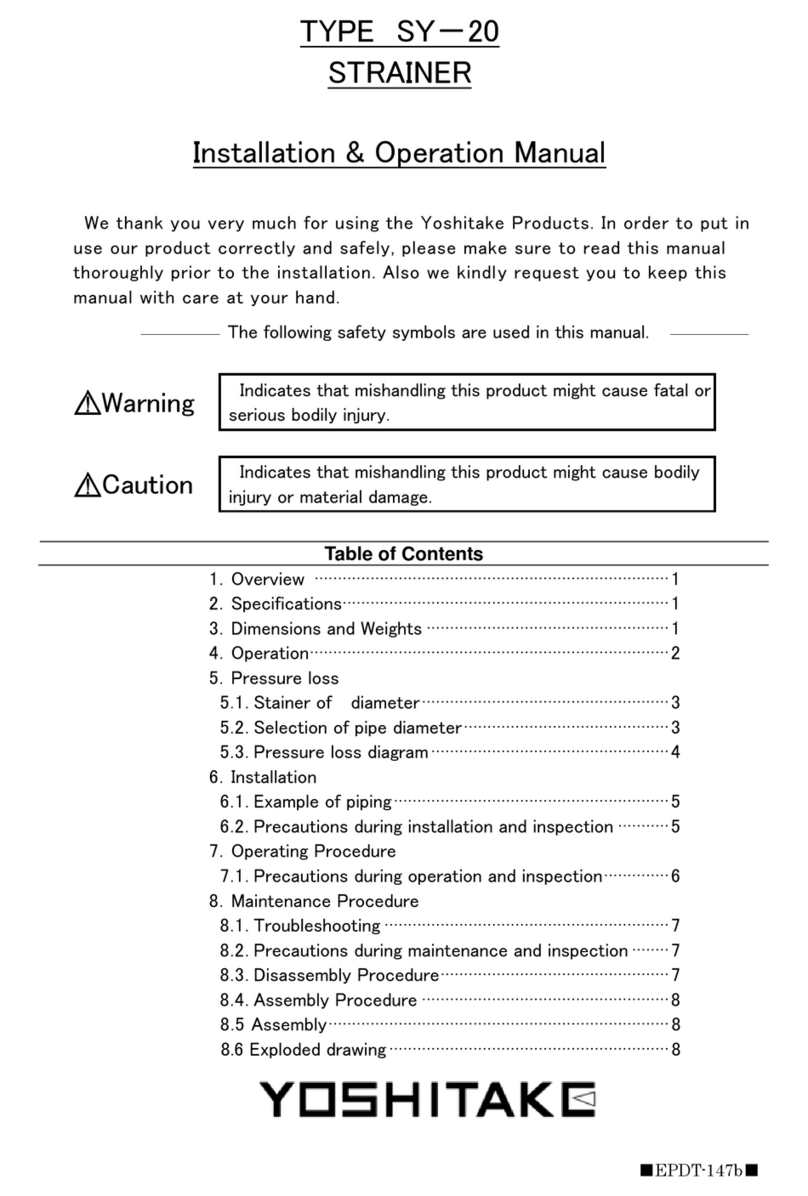
Yoshitake
Yoshitake SY-20-10 User manual
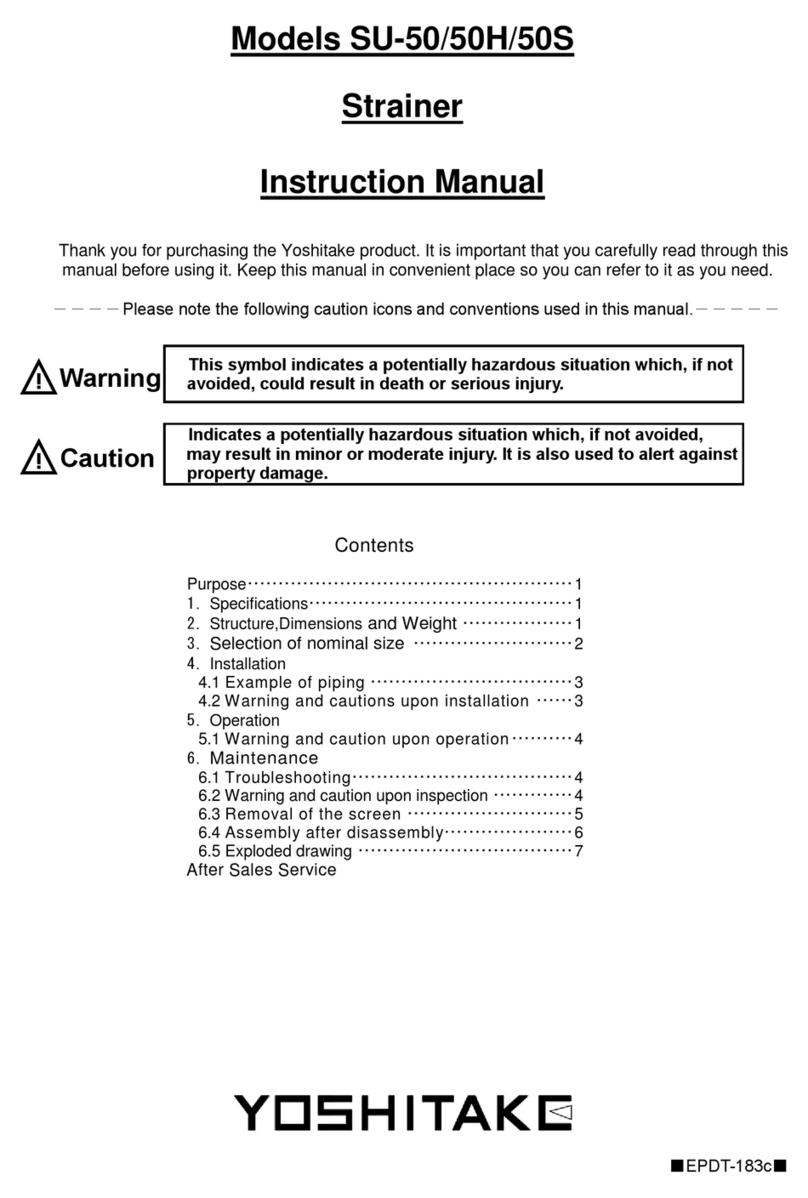
Yoshitake
Yoshitake SU-50 User manual
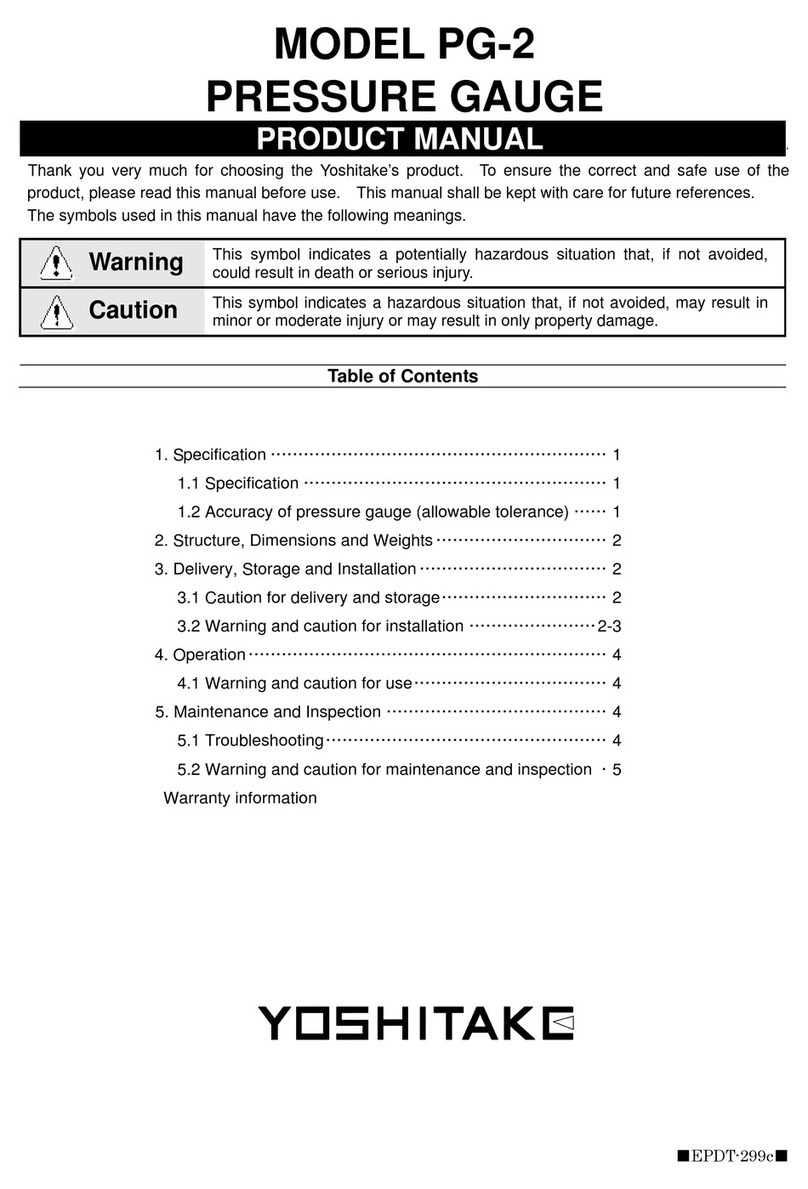
Yoshitake
Yoshitake PG-2 User manual
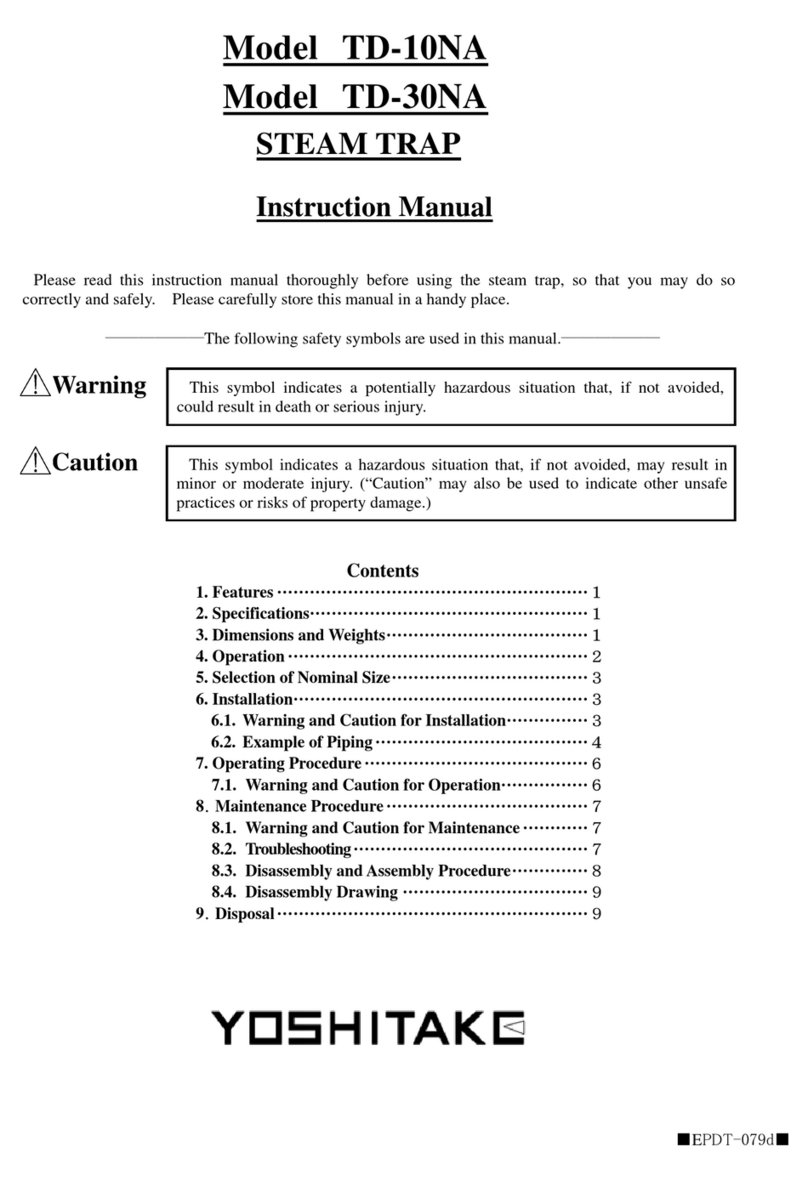
Yoshitake
Yoshitake TD-10NA User manual

Yoshitake
Yoshitake TRAP STAR TSF-12 Series User manual
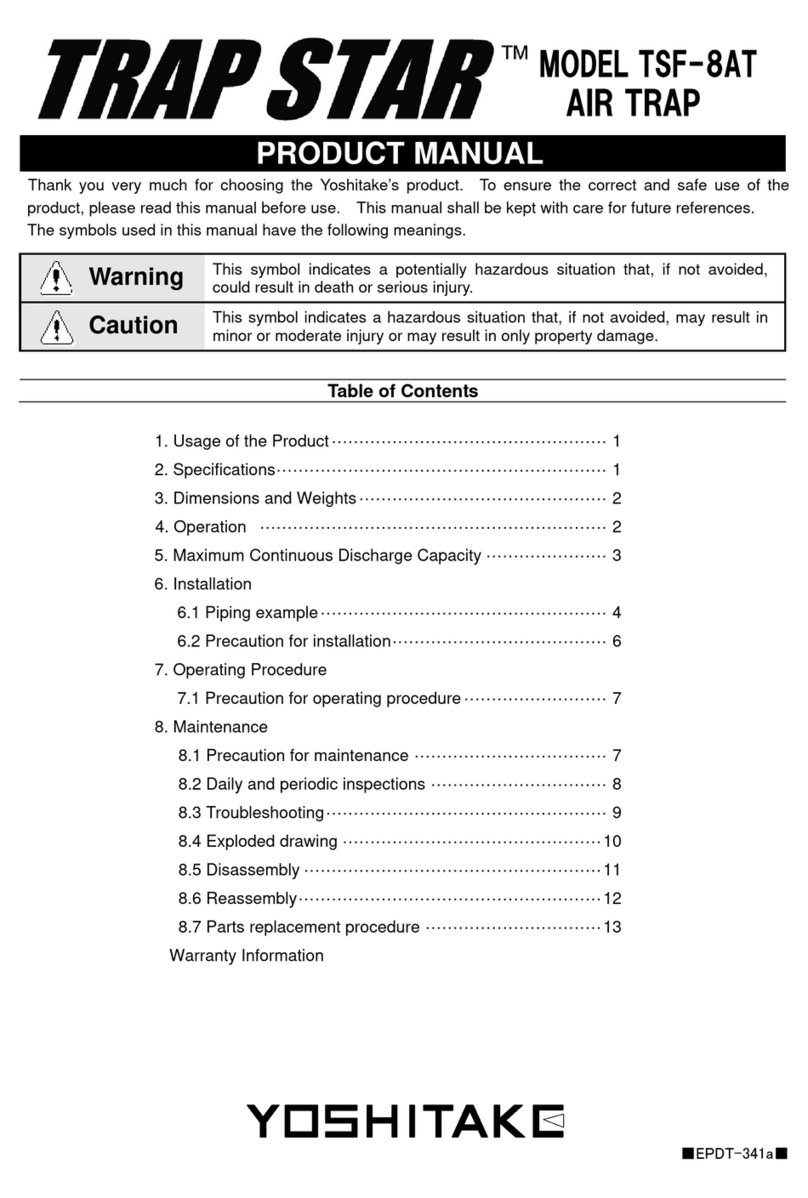
Yoshitake
Yoshitake Trap Star TSF-8AT User manual
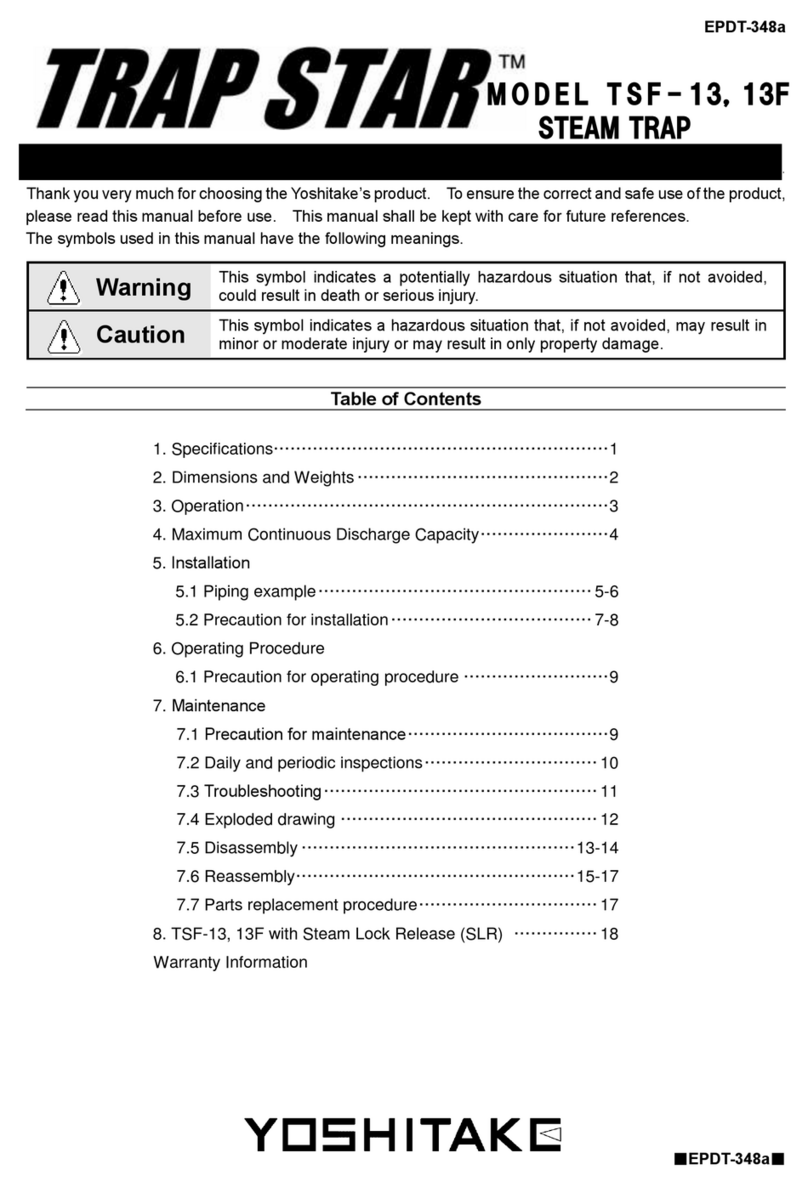
Yoshitake
Yoshitake Trap Star TSF-13 User manual
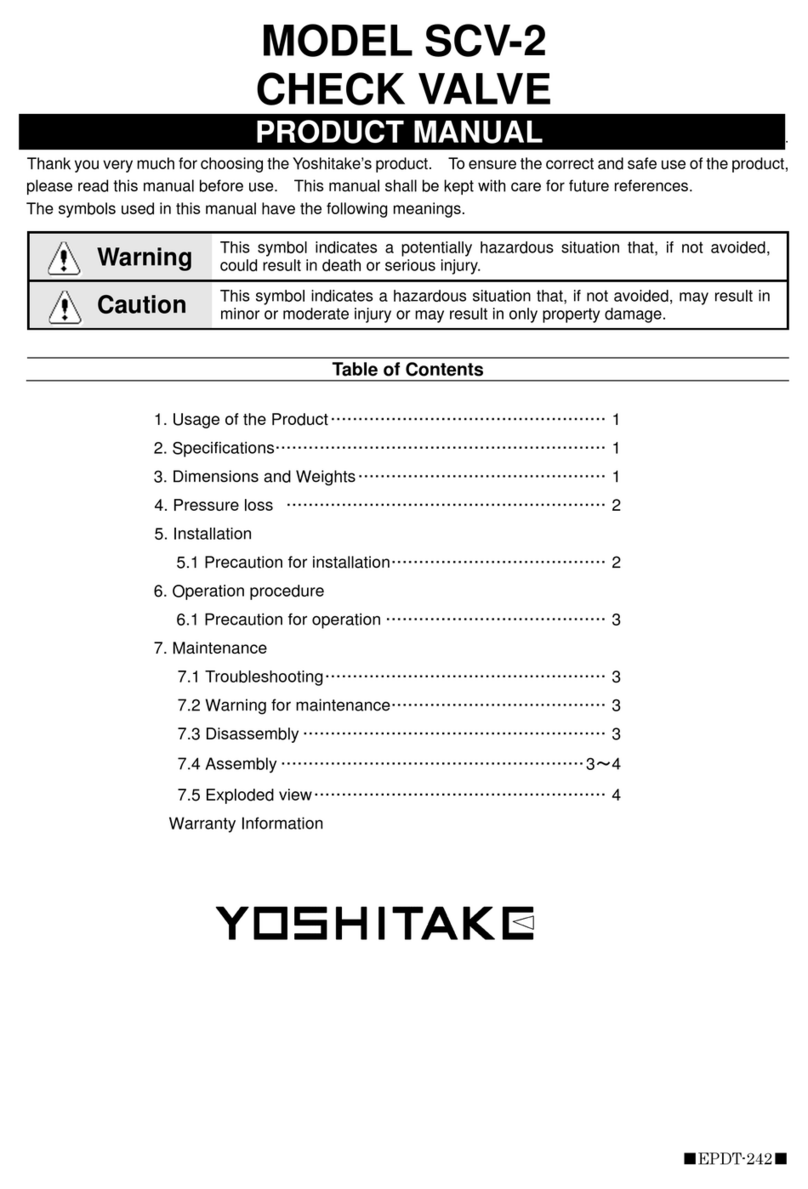
Yoshitake
Yoshitake SCV-2 User manual

Yoshitake
Yoshitake SY-8 User manual
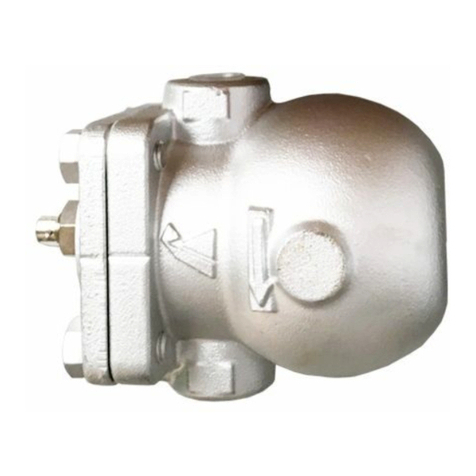
Yoshitake
Yoshitake TRAP STAR TSF-10 User manual
